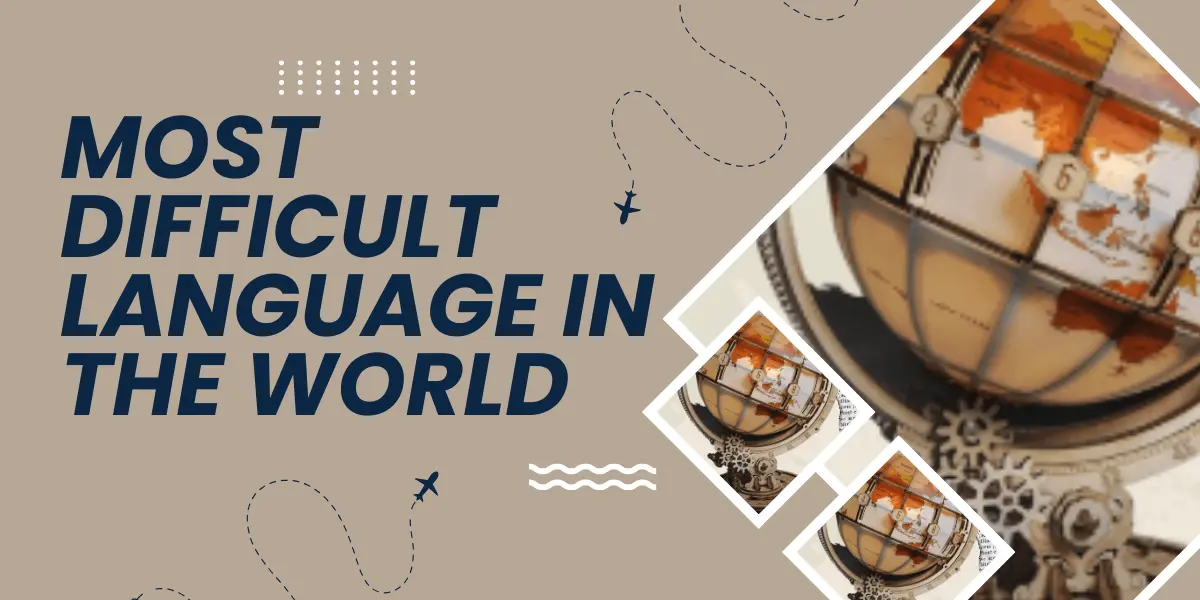Most Difficult Language in the World: Language is one of the most interesting things about human culture, it is how we communicate and express our thoughts with others. There are about 7,117 languages spoken across the planet — and each one presents its own unique challenges. Some languages are relatively easy to learn, others just deserve a place among the ten hardest due to complex grammar, pronunciation or script. This article offers an insider’s look at the 10 hardest languages to learn in the world, diving into why exactly these few stand out as being so difficult for both native speakers and second language learners.
What Makes Learning Needless So Hard?
But before we get into each language, it’s important to know what factors lead a language is considered difficult. Though the factors involved in this can change based on the learner’s L1, linguistic background and a variety of other factors. But, these are a few of the things that always make any language difficult to learn.
Grammar Complexity
Languages like German which have plenty of tenses, cases and exceptions could turn out to be frustrating not just for beginners but also for some experienced learners. There are also languages that include many complex case systems, as if you want to learn Russian or Finnish… these require a specific interest in grammatical structure.
Pronunciation and Phonology
The Challenge With Anything Language Related, Especially Speaking. Languages like Mandarin Chinese, which has unfamiliar sounds or tone differences in pronunciation as its features are that much more difficult. As you may have guessed, this becomes tough when these sounds do not even exist in the language of origin for that learner.
Script and Writing System
One example of this is how the writing system for a language has the power to make that respective language easier or harder. Japanese (Kanji, Hiragana, Katakana) and Arabic — whose script runs from right to left can be challenging for new learners.
Vocabulary and Lexicon
A wide range of vocabulary, along with the level use complex idiomatic expressions can cause language complexity(difficulty). It is further complicated by languages with lots of homophones, synonyms, and polysemous words.
Cultural & Contextual nuances
At one level, to understand a language you often need understanding of the culture and context in which it is spoken. Languages that are deeply rooted in cultural ritual, tradition and history will make challenges even greater for more than just their foreignness.
Hardest Languages in the World
Mandarin Chinese
Why It is Hard: Mandarin Chinese tends to be put at the top of most lists for its difficulty. This is a specific case of its tonality, and the main root of this difficult. Mandarin has four tones, and they are centre to being understood accurately. On the other hand, Mandarin has a few thousand logograms… or symbols that represent larger concepts and words about in Cantonese. Taken together, this palate of characters comprised of such intricate strokes can make learning how to read and write Mandarin seem quite terrifying.
Chinese culture is integral to the languageCultural Note This article examines how idiomatic expressions, historical references and cultural symbols contribute to the challenges of mastering Mandarin.
Arabic
Why It’s Hard: For much the same reasons as Hebrew, Arabic presents a host of challenges mostly on account to its script and pronunciation. Another challenge is in pronunciation, which has sounds that do not even exist elsewhere (ex: the glottal stop or emphatic consonants). Also, Arabic is a grammatically complex language with everything from imperfect verb conjugation changes based on tense and mood to person.
Vast Number of Dialects: The most daunting experience when learning Arabic is the sheer volume of dialectal variations. Modern Standard Arabic is used in formal contexts, but the regional dialects can vary greatly so that learners have difficulty understanding each other between different speaking world.
Japanese
Why It Is Not Easy: The writing system and grammar of Japanese are considered as two of the most difficult compared to other languages. Japanese writing system consists three scripts: Kanji, Hiragana and Katakana. The challenge is that Kanji do not have a 1:1 sound to meaning correspondence like English, but can be read and used in different ways. In Japanese, the grammar is difficult and the sentence formation are different from English. Japanese uses Subject Object Verb(suitable in english) while English Uses SOV or (Subject-Verb-Object). A whole other layer of complexity is the levels of politeness in Japanese, which changes with different social hierarchies.
Cultural Context : Japanese culture [V] puts a heavy weight on the etiquette and hierarchy in society, translated to language. Or learning about honorifics (or formal speech) is indispensable if you want to have truly good communication.
Korean
Why It’s Hard: The grammar of the Korean language is built on a unique sentence structure, and complex honorific system. It also has different levels of politeness so a learner must select the right level depending on who he or she is talking to. Korean is a language with lots homophones too, which makes discerning meaning from context even more difficult. Hangul may be a simple composing system, but the grammar and vocabulary are quite complex.
Honorifics and Politeness: Much like the Japanese use of honorific suffixes attached to language, Korean utilizes an intricate system rooted in Confucian values that include giving respect to elders and recognizing social hierarchy. For learners, this is one of the biggest hurdles to get over.
Finnish
Why It Is Tough: Finnish has a very complicated grammar structure and its case system is global famous. The language uses 15 (yes, fifteen) grammatical cases and unique endings that influence the meaning of words. Finnish also has a distinct system of vowel harmony, which puts restrictions on the order in which vowels may appear within one word. Finnish Has A Unique Vocabulary… Not much of Finnish sounds like common Indo-European languages, so it can be tough to find most any cognates or words that sound at least a little familiar.
A Quick Overview: Finnish is a minority language, spoken by fewer people and often only understood well within the confines of Finland itself.
Hungarian
Difficulty Level: High Hungarian has a complex case system with 18 cases affecting how nouns are inflected according to the role they play in a sentence. This is complemented by a distinctive word order — which can change depending on the point in question and context). Very little Hungarian vocabulary is shared with other European languages, which creates a challenge for learners in that there are not enough familiar words or word roots. Also used to a high degree in the Hungarian language is agglutination whereby several suffixes are added onto a root word to change its meaning.
Cultural Context: Hungarian is influenced heavily by the culture and history of Hungary, so it cannot be mastered without understanding these factors.
Icelandic
Why It Is Hard: Icelandic has changed little since the medieval era and preserved many archaic aspects of its form that make it difficult to learn. This also makes it tough for the modern age learners as they need to learn all those old grammatical rules and vocabulary. It also has a rather complicated system of inflection — in four grammatical cases, as well as many hindered verb conjugations. Icelandic pronunciation is tough, too as there are many sounds that have no resemblance to any sound heard in almost all other languages.
Icelandic is a language so closely associated with its own literature and history that learners are often encouraged to learn about it in order to have better understanding of the language itself.
Navajo
How Hard It Is: Navajo, an endangered language of the Uto-Aztecan family that really doesn’t resemble any other spoken in the modern world but has connections to languages from Alaska down through part of Mexico and Guatemala. Its language, which is very tonal and has a big review of the declension of verbs. This seems even more impossible with Navajo verbs, which can be prefixes or infixes that convey a host of meanings. In addition, the lack of loanwords from other languages will not be an advantage for those who learn it; you need to work harder to find familiar vocabulary.
Culture: The Navajo language is intrinsically connected to the culture and traditions of the Native American tribe. A deeper understanding of these cultural practices is often needed to understand the language.
Basque
Why It’s Hard: Basque is a language isolate with no known relations to other languages. This makes things very challenging, especially for learners since there are no roots/cognates that can be used as a reference. The Basque grammar is very complicated and the ergativity display — not frequently seen in other languages. Basque has a uniquely functioning vocabulary and multiple regional dialects, so the language itself is quite complex.
Polish
Why It’s A Challenge: Polish is a Slavic language with seven noun cases that all need to agree, so it has an intricate structure of nouns, pronouns and adjectives. The language also has a distinctive conjugation system with specific forms depending on the aspect of the verb (perfective or imperfective). Polish also makes pronunciation hard by incorporating many consonant clusters, and some are harsh sounds spoken at the back of the throat.
History and Culture: The Polish language has been shaped by its history [ ].
Conclusion
These words are some of the most challenging to learn in the languages for being extremely difficult when it comes to their complex grammar, pronunciation and writing systems as well a cultural continuums. Nonetheless, you can study and practice enough to acquire proficiency if (a big IF) :You dedicate your time with focus.You persist in learning.The language structure differences do not bother you immensely.
Whether you decide to tackle one of these tough languages or try another, the path of language learning is a window separate from cultural vision and perspective. An adventure that enlightens the soul and awakens one to a world filled with people so vividly different; yet never truly far apart.



